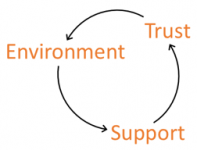In my previous post, I discussed ways in which anyone can become a leader by taking on small changes and letting these propagate throughout the organization. I now want to focus on how we want to think of these changes in terms of the third element. This third element comes in the form of the Agile Manifesto’s 5th principle:
Build projects around motivated individuals.
Give them the environment and support they need,
and trust them to get the job done.
When we begin these changes, we want to make them in terms of the environment; the climate and structures needed to help the team work better together. For example, can we make changes that opens dialogue or gives people more decision-making authority? Can we help people feel safe to bring up crucial topics that need to be addressed?
People also need support. While this support may be in the form of ensuring a team’s infrastructure is present, more valuable is where the environment rubber meets the team’s road of interactions. This is the how the environment gets enabled. For example, if we are striving for changes in establishing a safe environment, have we made changes in helping people understand how to be curious and look for root-cause as opposed to blaming? Have we been striving to create cognitive empathy so people understand each other better?
Lastly, we need to build trust as many of the changes we take on will aim at improving trust between people. These changes may incline us to answer the following question: How is the change we are making congruent with opening vulnerability between people?
Why is trust so important? Let’s look at a model for organizational trust as presented by Mayer, Davis, & Schoorman in the Academy of Management Review in 1995.

This model highlights that people have both a propensity for granting trust along with some factors that rate a person’s perceived trustworthiness: authority, benevolence, and integrity.
- For authority, a person will ask, how do I perceive that the person has the capability to get the job done, not just in skills, but also in their ability to not be overturned on what they do?
- For benevolence, one will ask, how likely is it the person will take advantage of me?
- For integrity, a person will reflect, will the person do what they say?
The propensity and perception of trustworthiness combines to give trust of a perceived risk to create a risk-taking relationship. This relationship creates vulnerability. When the final outcomes occur, each person involved will examine how well the other bore out their original perceived trustworthiness and readjust it. This results in a reinforcing loop. Small changes beget smaller perceived risks with less downside when they fail, and have an overall greater chance of success.
 As trust develops, we begin to grant more safety and authority for decisions we may have reserved for ourselves. This improves the environment. Then, changes that improve the environment beget changes that will increase support, which then can reinforce trust, making changes in the environment easier.
As trust develops, we begin to grant more safety and authority for decisions we may have reserved for ourselves. This improves the environment. Then, changes that improve the environment beget changes that will increase support, which then can reinforce trust, making changes in the environment easier.
There is, of course, more to it than this simple view. So, if you’re interested in learning more, join me at 10:45 AM on Wednesday August 9th when I present on Catalytic Leadership at Agile 2017.
In addition, for more ideas on how to freely introduce change and new patterns of work, I recommend reading three books: Liberating Structures, Fearless Change and More Fearless Change. These books are popular among Agile coaches as coaches are not given positional authority to make change. Instead, they can only lead change through influence and willingness. Yes, coaches are leaders too!